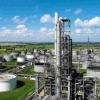Dear All,
I got a task for designing an air purification unit for a small air separation plant as my on job training task. Here are some data I have
Feed air flow rate = 780 Nm3/h
Feed air composition : N2 = 78.118 mol%
O2 = 20.95 mol%
Ar = 0.932 mol%
Feed air pressure = 7 barA
Relative humidity = 90%
Adsorber data
Type = TSA
Adsorbent type = Molecular Sieve 13X
Bed density = 650 kg/m3 (manufacturer data)
Adsorption time = 4 h
Adsorbent productivity = about 3 Nm3/kg.h (sampled from existing company purification unit)
Following the suggestion from "Industrial Gas Handbook" by Frank G. Kerry, the gas velocity through the bed should be around 10 cm/s during adsorption and the minimum quantity of adsorbent is 50 kg per 1000 Nm3/h of process air flow per 1 hour of adsorption
The adsorbent requirement:
Based on existing unit = 260 kg
Based on Kerry = 156 kg
Bed volume:
Based on existing unit = 0.4 m3
Based on Kerry = 0.24 m3
I calculated the superficial velocity based on the existing unit bed volume, 10 cm/s could be achieved by setting the H/D to 0.1. The velocity through the bed should be higher than 10 cm/s.
Trying to pursue 10 cm/s, I tried to split the flow into 2 until 4 parallel bed but the H/D still low, 0.25 for 4 beds in parallel.
Comparing to our existing purification unit, the superficial velocity is much higher, around 70-90 cm/s (I could not share the data of our existing unit)
Could someone give me some guidance on this problem? I attached my calculation.
Regards

 FB
FB













